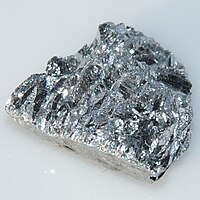
Photo from wikipedia
techniques can yield without going into so much detail about hardware. More relevant are the pages at the end of the chapter on the validity of older analytical data and… Click to show full abstract
techniques can yield without going into so much detail about hardware. More relevant are the pages at the end of the chapter on the validity of older analytical data and whether they may be combined with recent results. Chapters 3 through 9 are essentially the same as those appearing in the original edition updated with newer references where necessary. They still remain authoritative accounts of the various subjects covered such as pottery, obsidian, glass, and metal objects. The final three chapters represent material not in the first edition. Chapter 10, “The Chemistry of Human Bone. Diet, Nutrition, Status and Mobility”, concerns studies on human remains which can give information on such things as the geographical origin of the subject by study of the trace elements present in the remains. Such studies have been able to show, for example, that “The Amesbury Archer” had grown up in the region of the Swiss Alps and not locally. The next chapter deals with the identification of traces of dairy products (butter, cheese, and milk) remaining on ancient pottery by such techniques as GC–MS, MS alone, and isotope ratio determination. The work under the direction of Prof. R. P. Evershed at Bristol University figures largely in this chapter. Chapter 12 concerns the determination of traces of blood on archaeological remains. There is a detailed account of the chemistry of proteins and haemoglobin in blood. Several analytical techniques are involved, including immunoassay, electrophoresis, and mass spectrometry. The book ends with a short chapter entitled “Summary—Whither Archaeological Chemistry” which gives an account of the application of chemistry to archaeology over the years and over a range of materials. Like all analytical science, the trend is for smaller, cheaper, and quicker. Clearly, archaeology would be infinitely poorer in the absence of the application of all the analytical techniques currently available. In spite of my earlier cavils above, this is a book which must be read by all serious students of archaeology and also by those like me who would like to know more about the past. Bibliography Archaeological Chemistry. 3rd Edn A. Mark Pollard, Carl Heron, Ruth Ann Armitage Royal Society of Chemistry, 2017, Cambridge, UK, 2017, pp xxii + 585 ISBN 978-1-7826-2426-4 GBP 44.99
Journal Title: Chromatographia
Year Published: 2017
Link to full text (if available)
Share on Social Media: Sign Up to like & get
recommendations!